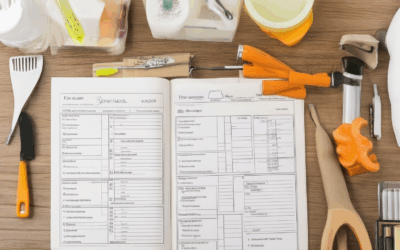DIY upkeep projects have become a cornerstone of modern homeownership, offering a creative and cost-effective way to enhance both the aesthetic and functional aspects of your living space. Whether you’re aiming to boost home value or simply wanting to save on maintenance costs, DIY upcycling projects provide a versatile solution for transforming neglected areas into vibrant, functional spaces. From quick fixes to ambitious renovations, these projects not only showcase your personal style but also deliver long-term benefits by preserving the integrity of your property. By tackling everything from routine maintenance to seasonal tasks, DIY efforts can ensure your home remains in peak condition year-round. This article delves into how DIY projects can elevate your home’s value, streamline maintenance routines, and even prioritize repairs based on urgency, all while keeping your budget in check. Discover the endless possibilities of DIY upcycling and how it can become your go-to strategy for maintaining and improving your home.
Key Takeaways
- Regular maintenance is crucial for preventing costly issues by addressing problems before they escalate.
- Adopt the 1% rule to budget effectively for home upkeep, ensuring long-term financial preparedness.
- Prioritize repairs starting with safety to avoid bigger problems and ensure a secure living environment.
- Exterior upgrades can significantly boost curb appeal, enhancing your home’s market value.
- DIY upcycling transforms spaces affordably while adding unique touches, allowing you to customize your home on a budget.
- Invest in HVAC, plumbing, and electrical systems to ensure their longevity and reliability.
- Use the 1% rule to allocate funds for unexpected repairs, helping you stay financially prepared.
- Seasonal maintenance ensures readiness for weather changes, keeping your home in optimal condition year-round.
- Focus on interior updates to enhance functionality and comfort, creating a more enjoyable living space.
- DIY projects allow recycling materials, reducing waste and promoting eco-friendly practices.
- Proactive maintenance preserves home value and keeps it sellable, ensuring a competitive edge when it comes to resale.
- Consult professionals when needed to handle complex tasks safely, balancing DIY efforts with expert advice.
- Upcycling modernizes older homes affordably, revitalizing your space without breaking the bank.
- Lawn care and landscaping add curb appeal and functionality, improving both aesthetics and usability.
- Budgeting for renovations with a 20% contingency is wise, preparing for unforeseen challenges during projects.
- Maintaining appliances prevents costly replacements, saving money in the long run.
- Address interior issues to create a more comfortable living space, focusing on resident well-being.
- Organize garages to improve functionality, enhancing overall home efficiency.
- Spring cleaning prepares the home for better weather, ensuring readiness for warmer seasons.
- DIY upcycling can personalize a home to individual tastes, allowing you to express your unique style.

Do DIY Projects Increase Home Value?
Yes, DIY projects can significantly enhance your home’s value. Whether you’re tackling small fixes or major renovations, well-executed DIY efforts can boost your property’s market value and attract potential buyers.
- Painting: A fresh coat of paint can transform a room’s appearance. Focus on high-traffic areas like walls, ceilings, and trim for maximum impact.
- Fixtures Update: Replacing outdated bathroom or kitchen fixtures can modernize your space and leave a lasting impression on buyers.
- Exterior Enhancements: Improving your home’s curb appeal with a new front door, garden landscaping, or deck refinishing can greatly increase its value.
- Kitchen Remodels: A well-planned kitchen renovation can add substantial value, making it one of the most rewarding DIY projects.
- Landscape Improvements: Spruce up your yard with new plants, a patio, or outdoor lighting to create an inviting outdoor space.
When executing DIY projects, prioritize quality and safety. Use reliable resources like HGTV and DIY Network for expert guidance. Additionally, explore Sams Maintenance’s tool guide for essential equipment recommendations.
Remember, the key to maximizing your home’s value lies in thoughtful planning and execution. By focusing on impactful yet manageable projects, you can achieve long-term returns through increased property value.
Are DIY Projects Cheaper?
Yes, DIY projects can often be cheaper than hiring professionals for certain tasks. The cost difference largely depends on several factors, including material prices, labor rates, and the complexity of the project.
Factors Influencing DIY Costs
- Material Costs: DIY allows you to shop around for the best prices on materials, potentially saving significant money compared to contractor markups.
- Labor Costs: Hiring professionals can add 50% or more to the total project cost due to labor fees. DIY eliminates this expense entirely.
- Project Complexity: Simple projects like painting or minor repairs may cost less when done yourself, while complex renovations could save money too, depending on your skills and tools.
- Tool Ownership: If you already own necessary tools, you can save on rental or purchasing costs associated with professional work.
Advantages of DIY Projects
- Saves Money: Eliminating labor costs can significantly reduce overall expenses.
- Skills Development: DIY projects allow you to learn new skills and gain confidence in home maintenance.
- Customization: You have full control over the final outcome, allowing for personalized touches.
- Environmental Impact: Reducing waste and minimizing the need for new materials can contribute to a more sustainable lifestyle.
Considerations Before DIY
- Time Investment: DIY projects take time, and may require more effort than expected.
- Tool Costs: Purchasing tools can be an upfront expense, though they often pay off over time.
- Permits and Regulations: Some projects may require permits or inspections, which can add to the process.
Conclusion
Diy projects can indeed be cheaper, but it’s essential to weigh the savings against your time, skill level, and the tools you currently have. For more guidance on getting started, check out our maintenance guide and explore our tools section for recommended equipment.

Home Maintenance Checklist: Essential Tasks for Every Homeowner
Regular home maintenance is crucial for preserving the value of your property and ensuring comfort and safety. Here’s a comprehensive guide to essential tasks every homeowner should tackle:
Exterior Maintenance
- Foundation Check: Inspect for cracks, gaps, or shifting. Use a flashlight to examine the base of walls and around windows.
- Gutter Cleaning: Remove debris and ensure downspouts are clear. Extend downspouts to prevent water pooling.
- Roof Inspection: Look for missing shingles or tiles. Walk around the perimeter to identify potential issues.
- Window Care: Clean glass and frames. Check for cracks or peeling paint to maintain energy efficiency and aesthetics.
- Exterior Lighting: Adjust fixtures to avoid illuminating windows at night. Clean lenses for optimal light output.
Interior Maintenance
- HVAC System: Change air filters monthly. Program the thermostat for energy efficiency. Consider professional duct cleaning for improved airflow.
- Appliance Care: Clean refrigerator coils, check stove burners and exhaust vents, and maintain garbage disposal by running it with ice and using baking soda.
- Water Heater: Drain the tank weekly and check the pressure relief valve for leaks or damage.
- Electrical Systems: Test outlets with a lamp or radio. Reset tripped circuit breakers and ensure GFCI outlets function properly.
- Plumbing Checks: Clean faucet aerators, inspect pipes for corrosion, and adjust toilet float mechanisms. Test faucets for water pressure and discoloration.
Fire Safety and Security
- Smoke Detectors: Test and reset alarms monthly. Replace batteries as needed.
- Carbon Monoxide Detectors: Check functionality and battery status, especially with gas appliances.
- Security Systems: Verify lock functionality and test alarm systems. Inspect window locks and sliding door security.
Seasonal and Landscaping Tasks
- Fall Preparation: Rake leaves, clear gutters, and check for ice dam potential on roofs.
- Winter Preparation: Clear snow from the roof and inspect for ice dams. Consider professional insulation checks.
- Pruning Trees: Trim overhanging branches to prevent damage and maintain visibility.
- Landscape Management: Control weeds promptly and seal entry points to deter pests.
Pest Control
- Seal Entry Points: Use caulk or weatherstripping to prevent pests from entering the home.
- Pest Traps: Set traps for mice and insects around the property.
- Insecticide Application: Apply treatments to targeted areas, following safety guidelines.
Monthly Maintenance Routine
Set aside time each month to address these tasks. Some, like checking smoke detectors, are quick, while others may require more effort. Regular maintenance helps prevent costly issues and ensures your home remains in great shape throughout the year.
By tackling these home maintenance tasks, you’ll enjoy a safe, comfortable living environment and protect your investment for years to come.

What Routine Maintenance Is Required for a House?
Keeping your house in great shape requires regular maintenance to prevent issues before they arise. Here’s a comprehensive guide to the essential tasks:
- Exterior Maintenance
- Gutter Cleaning – Remove debris and check for leaks.
- Roof Inspection – Look for missing shingles or damage.
- Painting – Refresh exterior surfaces every 3-5 years.
- Deck Maintenance – Check for warped boards or loose nails.
- Window Checks – Inspect frames for cracks or peeling paint.
- Interior Maintenance
- Cleaning – Dust, vacuum, and mop regularly.
- Flooring – Inspect for wear and tear or stains.
- Appliances – Clean coils, vents, and exhaust fans.
- Bathrooms – Check for water damage and leaky fixtures.
- Kitchen – Clean sinks, stovetops, and cabinets.
- HVAC and Plumbing
- Filter Changes – Replace or clean air filters monthly.
- AC Check – Ensure units are running efficiently.
- Water Heater – Flushing and testing for leaks.
- Drain Cleaning – Use a snake to remove clogs.
- Electrical Systems
- Outlet Checks – Test GFCIs and replace faulty outlets.
- Switchboards – Inspect for tripped breakers.
- Lighting – Replace bulbs as needed and clean fixture plates.
- Landscaping
- Lawn Care – Mow, edge, and fertilize regularly.
- Garden Maintenance – Prune trees and shrubs.
- Patio and Driveway – Clean and check for cracks.
What is the 1% Rule for Home Maintenance?
The 1% rule for home maintenance is a simple yet effective strategy to ensure your property stays in great shape. Here’s how it works:
- Set Aside 1% Annually: Start by calculating 1% of your home’s purchase price. This amount should be reserved yearly for maintenance expenses.
- Regular Inspections: Schedule regular check-ups for systems like HVAC, plumbing, and roofing to catch issues early.
- Budget for Repairs: Allocate funds for unexpected repairs, such as fixing a leaky roof or replacing an appliance.
- Monitor Renovations: If you’re planning renovations, set aside 20% of the budget for unforeseen challenges or changes.
Why does this rule matter? Proper maintenance prevents small issues from becoming big problems, saving you money in the long run. By staying proactive, you can enjoy a comfortable and safe living environment without unexpected surprises.
To make this process easier, visit our maintenance resources for expert tips and tools to keep your home in top shape. Remember, a little preparation goes a long way in preserving your investment!
Looking for more guidance? Check out our partner site or explore similar resources for additional insights and actionable steps.

What House Repairs Should Be Done First?
When it comes to determining which house repairs should be addressed first, prioritization is key to ensure both safety and efficiency. Here’s a structured approach to guide you:
- Safety Checks First
- Heating, Ventilation, and Air Conditioning (HVAC): Ensure your furnace, air conditioning, and ductwork are functioning properly. A malfunctioning HVAC system can lead to uncomfortable living conditions and costly repairs.
- Plumbing System: Address leaky pipes, clogged drains, or faulty water heaters promptly to prevent water damage and further complications.
- Electrical System: Check for tripped breakers, loose wires, or outdated electrical panels. Safeguarding your home’s electrical system is non-negotiable for safety.
- Exterior Maintenance
- Roofing: Inspect for missing shingles, cracks, or damage. A damaged roof can lead to water infiltration and structural issues.
- Painting: Peeling or flaking paint on the exterior can indicate underlying issues. Address it to maintain your home’s curb appeal and protection against the elements.
- Deck and Fence Repair: Replace rotten wood or unstable structures to ensure the integrity of your outdoor spaces.
- Major Systems Inspection
- Water Heater and Pipes: Regularly inspect and maintain your water heater and plumbing systems to prevent breakdowns and leaks.
- Appliances: Ensure your refrigerator, stove, and dishwasher are operating correctly to avoid costly replacements or malfunctions.
- Minor Repairs and Upkeep
- Broken Items: Fix or replace items like broken windows, doors, or appliances to prevent further damage or inconvenience.
- Plumbing Fixes: Handle small leaks or clogs immediately to avoid more significant issues down the line.
- Interior Projects
- Kitchen and Bathroom Updates: Plan for renovations after immediate repairs to enhance functionality and aesthetics.
- Wall Repairs: Patch cracks or holes to maintain a clean and safe indoor environment.
- Flooring and Ceiling Repairs: Address uneven floors or peeling ceilings to restore comfort and appearance.
- Garage and Storage Areas
- Organize and Maintain: Keep the garage clutter-free and ensure storage solutions are functional to streamline daily life.
- Inspect for Damage: Look for signs of wear and tear in garage doors or stored items to prevent future issues.
- Seasonal Maintenance
- Pre-Winter Preparation: Inspect and prepare for colder weather, such as clearing gutters and ensuring heating systems are ready for the season.
- Spring Cleaning: Address maintenance tasks that benefit from better weather, like lawn care and deep cleaning.
Conclusion: Prioritize repairs based on safety, functionality, and the potential impact on your household’s well-being. Regular maintenance and addressing issues as they arise will help preserve your home’s value and ensure a comfortable living environment. Always consult professional contractors when in doubt to handle complex repairs safely and effectively.




0 Comments